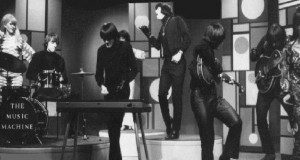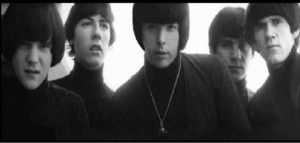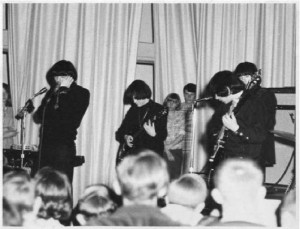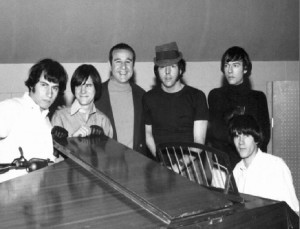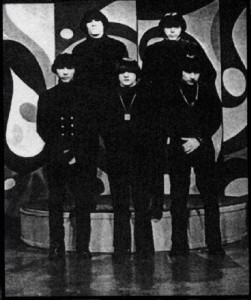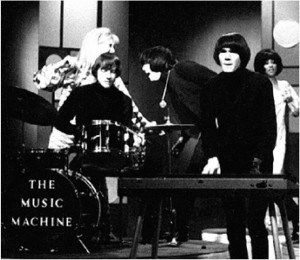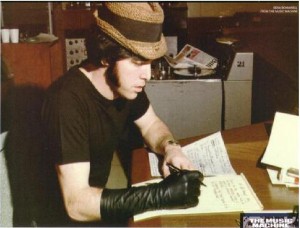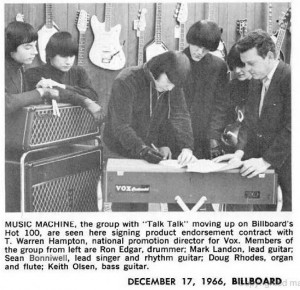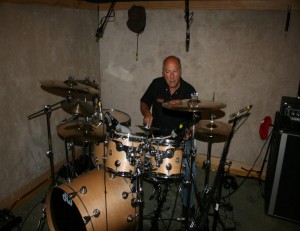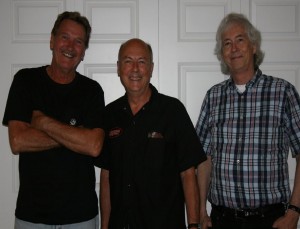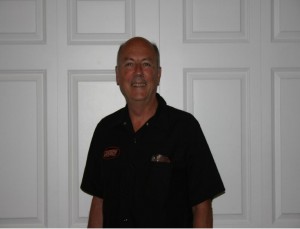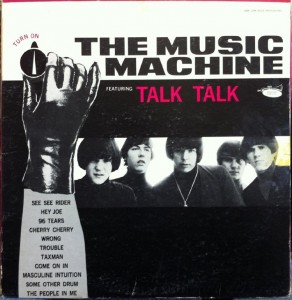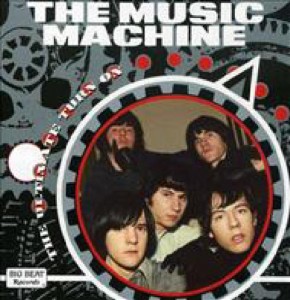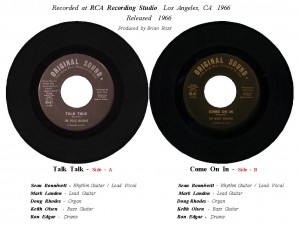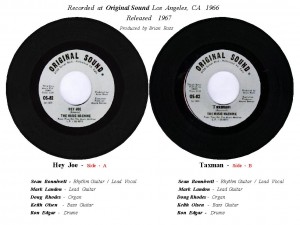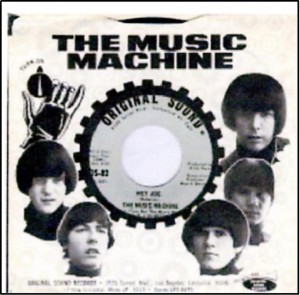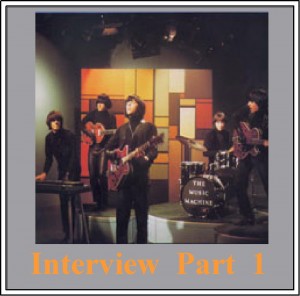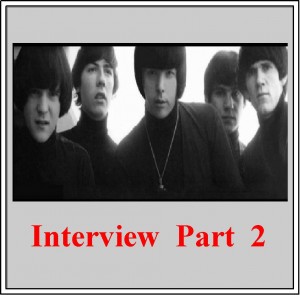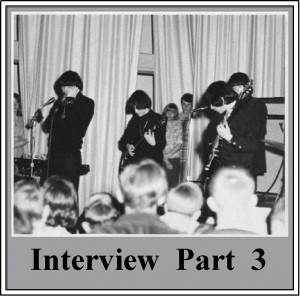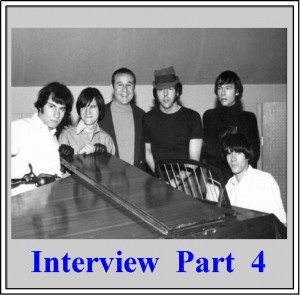Music Machine (Ron Edgar and Keith Olsen)
“Talk Talk” by The Music Machine puts the band in the history books with a garage rock classic
History
The Music Machine
(1966 to 1967)
1964: Ron Edgar is a senior at Hopkins Senior High School, a drummer who had started playing at 12 or 13 years old and had an interest in jazz music. Ron gets together with Eldon Ferdine, a guitar player and Larry Hutchinson, who plays upright bass. The three form a band called The Contemporary Jazz Trio and play for a prom dance at Hopkins High. The trio also plays for fashion shows at the Lemington Hotel in Minneapolis and weekend jobs at Valley Pizza in Hopkins. The band practices at Larry Hutchinson’s home in South Minneapolis on Lake Street.
Another band also uses the home for band practice, The GoldeBriars, a folk quartet with two sisters from Minnesota, Sheri and Dotti Holmberg. Also in the group are Curt Boettcher (from Eau Claire, Wisconsin) on acoustic guitar and vocals and Ron Neilson (from Minneapolis) on banjo and guitar. The Goldebriars have one album out on the Epic label and a second album is finished but not yet released. The group travel the country playing mainly at folk clubs and are under contract to record a third album for Epic.
September, 1964: Ron Neilson leaves The GoldeBriars and new members join: Ron Edgar on drums; Tom Dorholt on bass guitar; and Murray Planta on lead guitar and harmonica. The group is moving away from folk and into pop. The band dresses in the “bohemian” look of the time with black turtle necks shirts and all have their hair dyed black. The guys wear one ear ring.
The reformed band plays at a relatively new folk club in Charleston, South Carolina called 300 King Street. The Wayfarers, a folk quartet that include vocalist and guitar player Sean Bonniwell, own the club. The Wayfarers have released numerous folk albums on the RCA label.
December, 1964: The band travels to New York City and record their third album.
Keith Olsen, a transplant from South Dakota is a student at Washburn High in South Minneapolis and has a strong interest in electronics, recording, jazz music and plays bass guitar. Keith works as an apprentice at local recording studios and records a number of local acts at various clubs including a popular folk club, “Nine O’Clock Scholar” in Dinkytown, near the University of Minnesota. The club is owned by Connie Hechter, who will go on to publish a local music magazine called “Connie’s Insider” and will also start up the annual Connie Awards. After playing stand up bass as a sideman for various artists including Jimmy Rodgers, Keith gets a steady job playing with folk singer Gale Garnett who has a national hit with the folk-pop ballad “We’ll Sing in the Sunshine.”
During a job at The Cellar Door in Washington, DC, The GoldeBriars meet up with Gale Garnett and Keith Olsen. Ron discovers Keith is not all that happy playing bass for Gale Garnett.
December, 1964: The GoldeBriars are back at 300 King Street where they have developed a fan base. Sean Bonniwell is no longer happy playing folk music and wants to move to California to start a rock band. When the band gets a booking in Denver, Sean volunteers to be their road manager and join them on the trip out west. The Wayfarers come to an end.
February, 1965: The GoldeBriars play at The Exodus in Denver, Colorado. Sean also acts as their business manager and takes a promo photo of the band.
March, 1965: The band is booked at The Ice House in Pasadena, California for three weeks, followed by a three week job at The Mecca in Buena Park. The last week at The Mecca they share the stage with Gale Garnett. They also are staying at the same motel and Sean Bonniwell and Keith Olsen get together and make plans to start a new rock band.
May 1, 1965: Ron Edgar leaves The GoldeBriars and joins Sean and Keith in their new band called The Ragamuffins. Pooling their money, the three are able to construct a plywood cabinet, paint it black, cut holes in it for speakers and mount a Bogen PA amplifier inside with three inputs (vocals, guitar and bass guitar)… resulting in a heavily distorted sound.
The band rehearses in a garage in San Pedro (South of Los Angeles), at the home of Sean’s girlfriend, located on El Mira Street. Sean sings lead and plays guitar, Keith plays bass guitar, and Ron plays drums. Sean, a few years older than Ron and Keith, is the leader of the group. A small bar/restaurant in the city provides a weekend job for the group.
The band learns to play original songs written by Sean, as well as covers by The Rolling Stones, The Kinks, The Turtles, and other popular rock bands.
The Ragamuffins travel to Las Vegas (in October) and play a job at a lounge on the Strip called the Pussycat A Go-Go. Another club in the Los Angeles area where the band performs is the Insomniac in Hermosa Beach, where they play afternoon shows that start at 3:00 pm. In the San Fernando Valley the band plays at The Casbah, a small club in Canoga Park.
Always experimenting with sound effects, Keith picks up a few cheap electronic parts at a Radio Shack and puts together a homemade fuzz tone switch.
1966: The band records a demo tape with songwriters/producers Tommy Boyce and Bobby Hart. Tommy and Bobby inform the band they need to get a lead guitar player.
Keith Olsen stops by a music store, Adler Music in Van Nuys. Guitar player Mark Landon is working at the store. Keith and Mark jam together in the amp room. Keith informs Mark that he is in a band and Mark stops by to see The Ragamuffins playing at The Casbah Club. Mark is highly impressed with the band and is hired to play lead guitar. The group is now a four piece rock band. Soon after Mark joins the band, Doug Rhodes joins on keyboards, making the band a five-piece. Sean decides to rename the band The Music Machine. The band follows a strict regiment of practice at the garage in San Pedro with a focus on the original songs written by Sean.
Sean comes up with a new look for the band: all black clothes, black dyed hair with “mop top” cuts, and one black leather glove for each band member. Sean’s idea is to present a unified image for the band. In addition, the band paints all their musical equipment black (Ron had purchased a black colored Rogers drum set).
Local record producer Brian Ross checks out The Music Machine playing live at a bowling alley, Hollywood Legion Lanes (the first club where the band plays under the new name). Brian likes the band and wants to produce them.
July, 1966: Brian Ross takes the band in to RCA Records (Studio C) to record a number of demo songs. Among the songs is “Talk, Talk” written by Sean.
The band shops the demo tape and sign a contract with Art Laboe of Original Sound, a record label that featured a series of compilation albums titled “Oldies but Goodies” named after a 1950’s pop hit. Art Laboe informs the band they need to include some cover songs on their first album and the band records in the Original Sound 10 track studio, custom built and run by Paul Buff.
December 28, 1966: The band plays their first big concert at the Santa Monica Civic Auditorium. The Beach Boys are the headline act. Other groups on the bill are: Jefferson Airplane; The Seeds; Sopwith Camel; and The Royal Guardsmen.
Fall, 1966: “Talk Talk” is released on Original Sound as a 45 with “Come on Up” on the flipside. “Talk Talk” is a raw, edgy and somewhat dark exploration of social isolation and seems to sound like no other recordings at the time, clocking in at just under two minutes (1:58). The song first enters the Billboard Top 100 on November 12, 1966 at number 96 and begins to climb higher on the charts with each passing week. As the song climbs the charts the band plays the popular music shows on television at the time including “Where the Action Is” and “Hullabaloo.” In addition, the group embarks on a number of tours including the west coast, the south and the Midwest (with breaks taken back in Los Angeles).
January, 1967: “Talk Talk” peaks on the Billboard Top 100 at number 15 on January 14, 1967. The song stays on the charts for 12 weeks before dropping off the Top 100 at the end of January (4 of the weeks were in the top 20).
An album is released on Original Sound, “(Turn On) The Music Machine.” The album has 12 songs, 7 of the 12 songs are originals written by Sean Bonniwell.
The Music Machine plays live at the Saint Paul Winter Carnival. Also on the ticket are The Blues Magoo’s from New York who have a national hit with “We Ain’t Got Nothing Yet.” Following the job in Saint Paul, the band travels to the University of Minnesota, Morris campus for a concert.
February, 1967: A follow up 45 on Original Sound is released with “The People in Me” backed with “Masculine Intuition.” The record does not do as well as “Talk Talk” and peaks at number 66 on March, 1967, staying on the charts for 8 weeks.
The band continues to tour the country.
February 17 and 18, 1967: The band plays at Action City in Brooklyn, New York.
Original Sound releases another three 45’s by the original band (all in 1967):
“Double Yellow Line” backed with “Absolutely Positively”
“The Eagle Never Hunts the Fly” backed with “I’ve Loved You”
“Hey Joe” backed with “Taxman” (the band’s version of “Hey Joe” is the first slow version of the song to be recorded, prior to the Jimi Hendrix version).
None of the 45’s meet with the same chart success as “Talk Talk.”
March 1, 1967: The band plays a job with Blue Cheer at The Cheetah in Venice, California. The Cheetah (1 Navy Street) was originally the Aragon Ballroom.
Mid 1967: A rift develops in the band between Sean and the other members. Sean is offered a record deal with Warner Brothers. Sean puts together a new band and starts work on a new album under the name: The Bonniwell Music Machine. Ironically, his album on Warner Brothers will include a number of songs recorded by the original band members.
The original version of The Music Machine comes to an end after fourteen months.
Update
The Music Machine at the St. Paul Winter Carnival in January, 1967
In July, 2010, Denny Johnson recalled going to see The Music Machine (along with Dave Waggoner and Pete Huber) perform at Roy Wilkins Auditorium for the St. Paul Winter Carnival in January, 1967. Denny reported the following: “There were a lot of bands there on the bill that night, at least five bands, including The Blues Magoos. The Music Machine came out in the dark, all wearing black clothes and all of them had mop top style black hair. Each one also wore one black glove. Still in the dark, the band members got their instruments ready and they all faced backwards to the crowd. They started to play their first song of the set and all the lights came on. They still had their backs to the crowd. About one minute into the song the band members all turned around to face the crowd. This was very unusual, but impressive at the time. I had never seen any band do this type of a stage show before. They finished off their set with their big hit “Talk Talk” and I thought they were excellent. “
“Talk Talk” by The Music Machine (Looking back from 2013)
On a July 30, 1966, Sean Bonniwell and his brothers in black entered RCA Records (Studio C) in Los Angeles to record a number of their original songs for a demo tape. Among the band members were Ron Edgar, a Minnesota native from St. Louis Park and Keith Olsen, a Minnesota transplant from South Dakota. One of the songs recorded that day was “Talk Talk” which would turn into a national hit and bring the band some fame but not much fortune. The song is a masterpiece by any standards and sounds as fresh and full of life in 2013 as it did in 1966. To hear it once is to hear it always, as every note and every word seems to become imprinted in the mind of the listener… a two minute song that lasts forever. The song is a total original (odd to think of the label name now, Original Sound) and sounds like no other song from 1966, prior to 1966 or after 1966. Most music critics and fans say it is a garage rock classic, which of course it is… however, the song transcends the standard music categories. Every note, every sound, every growling lyric is perfect, nothing could ever be improved upon… a testament to the vision and the genius of Sean Bonniwell and his determination to be different than any other rock band which he accomplished with the combined talents of all of the group members.
Somewhere in the port city of San Pedro, far South of glamorous Hollywood and the famous Sunset Strip there is a simple and plain garage (one car) where the band practiced and first learned to play “Talk Talk.” In the world of rock’n’roll it is probably the most famous garage of all time. Perhaps at some point in time there will be a plaque of some kind attached to the garage that will state something similar to: “In this garage in 1966 a band called The Music Machine first played “Talk Talk” which became a national hit and is now considered to be one of the greatest rock’n’roll songs of all time. “
Tom Campbell
May 27, 2013
Email Interview with Mark Landon by Tom Campbell
July 30, 2016
We recently heard from Mark Landon, guitar player with The Music Machine. Mark informed us that the 50th anniversary of the recording of “Talk Talk” was on July 30, 2016. We decided it was a good time to do an email interview with Mark. Mark was good enough to provide us with some of his memories and insights on the days of The Music Machine.
Tom: Were you in The Ragamuffins before they became The Music Machine?
Mark: The group was still The Ragamuffins when I joined, it was only after we added Doug Rhodes, who had been known by Ron and Keith, as they were all involved in Curt Boettcher’s The Millennium project, we began crafting The Music Machine sound and image.
Tom: How did you come to join the band?
Mark: I was between bands working at the Adler Music Company in Van Nuys. Keith Olsen came in and we started jamming in the amp room. We hit it off and Keith’s playing was impressive. He asked me to come out and hear his band The Ragamuffins as they were looking for a lead guitarist. The Ragamuffins were playing in a little Valley joint called The Casbah. I went… they were not just good they were different. The rest as they say is history.
Tom: When did you start playing in bands?
Mark: I started playing in bands early, at North Hollywood High School about 1963. I played rhythm guitar in The Tegrams 4, a primarily instrumental surf music band as was popular at the time. The lead guitarist was Alan Wisdom. By 1965, The Tegrams 4, now high school grads, had morphed into The Purple Gang, an avant garde pop group, now with management by well known record producer Tony Richland and his wife Rosemary and a recording contract with Jerden Records. When I left The Music Machine years later, Alan took my spot in what became The Bonniwell Music Machine.
Tom: Do you recall the first job you played as The Music Machine?
Mark: Our first job as The Music Machine was at the Hollywood Legion Lanes Bowling Alley, affectionately referred to as The Hollywood Bowl. I do remember the first Music Machine gig after “Talk Talk” hit. It was our first concert, with Sonny and Cher I believe and other hit groups of the day at the Santa Monic Civic Auditorium. I was scared to death although no one knew it.
Tom: On July 30, 1966 the band recorded “Talk, Talk.” What do you recall about the session?
Mark: We recorded our first single at RCA Recording Studios on Sunset Boulevard in Hollywood. The Rolling Stones had been recording there as well as The Monkees when we got there. I seem to remember Mickey Dolenz, with a bucket and a brush, painting the inside of their studio with bright psychedelic colors. It must have cost a ton to restore that studio when they left. I don’t remember how many takes we did. I am sure I overdubbed the guitar solos and I am sure Sean’s vocals were separate as well. Keith, ever the engineer/producer would know more of those details.
Tom: What key was “Talk Talk” recorded in?
Mark: To get a darker, powerful, more guttural sound than our contemporaries and using heavy gauge strings without buzz, we tuned way down to D Flat, since we played “Talk Talk” in F Sharp, that would actually put it at E Flat. We got a kick out of playing all the TV shows, knowing the young players watching would never figure all this out and therefore would never be able to duplicate our sound (lol).
Tom: What kind of guitar did you play on “Talk Talk”?
Mark: I played either my old Fender Telecaster or my 65 Guild Starfire, not sure which. Keith played his Italian made Eko Bass.
Tom: Did you think the song would become a hit?
Mark: We had done our work well. “Talk Talk” was the right song for the time. I never doubted its hit potential. The only question was Original Sound’s promotion and management.
Tom: Do you recall the first time you heard “Talk Talk” on the radio?
Mark: I was in my 57 Chevy Bel-Air Convertible, with friends and girls, driving East on the Sunset Strip at Crescent Heights. KHJ AM played “Talk Talk.” After all the years of work, drama, good times and bad, my first thought was… it’s about time.
Tom: How did you like touring? High points? Low points?
Mark: I loved it, still do. High point… too many girls. Low point… too many girls (lol).
Tom: Denny Johnson saw the band play in St. Paul in January, 1967 (with The Blues Magoos and others) for the Saint Paul Winter Carnival. Do you recall that job? Denny noted that when the group came on stage, all the band members had their back to the audience and then turned to face the audience about a minute into the first song. Did you do this at all your jobs?
Mark: Of course I remember the St. Paul Winter Carnival. Ron spoke of nothing else when we were booked there. It was great fun!! The papers made it something of a competition between us and The Blues Magoo’s, although it never was. We tried all kinds of dramatic staging for effect, again trying to separate ourselves from the peace, love, Hare Krishna, hippie crowd… the result: Denny Johnson remembers it half a century later.
Tom: How did you feel when the band ended?
Mark: I felt disrespected by Sean, Original Sound Records, and Gear Management. I felt put upon, used, and financially cheated. I had received essentially nothing for my years of effort, living in hotels up and down the Sunset Strip, buying our manager’s old used car, when he bought a new Lincoln Continental and I had to pay it off on time because I had no cash. When the group broke up our other manager bought a beautiful new home at the top of Laurel Canyon and Mulholland Drive, overlooking Hollywood and moved in. I moved into the back seat of my car.
Tom: What did you do after The Music Machine?
Mark: I was crazy about the blues and left rock behind after The Music Machine. In 1969 I joined Ike and Tina Turner with whom I toured and recorded for the next few years. I met Ike at a recording session with Albert Collins who he was producing. After Ike and Tina Turner, I formed my own blues/rock group called Freight Train. By the mid to late 70’s the scene was all about either disco or punk. There was no place to play the blues on the West Coast. When my house was burglarized and all my guitars, amps, and musical and recording gear was stolen, I walked away. I did not own a guitar again for 18 years.
Tom: What did you do next?
Mark: I built a new 33 year career as a Hollywood film and TV makeup artist for which I am lucky enough to have been nominated for 5 Emmy Awards and won 2 Emmy Awards for makeup. I bought a guitar again in the mid 90’s.
Tom: How did you wind up in Austin, Texas?
Mark: When I retired from film three years ago I moved to the amazing live music town of Austin, Texas to play the blues again. I record at home and play jam sessions all around Austin. Who knows, maybe I will put another band together.
Tom: Do the musicians you meet in Austin, Texas know about your time in The Music Machine?
Mark: Yes, both The Music Machine and Ike and Tina Turner are held in high esteem here.
Tom: When you think about Sean, what do you remember most?
Mark: Talent and ego in equal amounts.
Tom: When you think about Ron, what do you remember most?
Mark: Ron was one of the nicest guys you’d ever meet… unaffected, talented, and a good friend all through the years until he passed away recently.
Tom: Do you keep in touch with Keith and Doug?
Mark: I stay in touch with Keith, tremendously talented and a good friend all through the years. I have not spoken with Doug since the 60’s.
Tom: Do you still have the “Talk Talk” guitar?
Mark: No. My first Guild Starfire was stolen from the stage at the Hollywood Legion Lanes Bowling Alley, where record producer Brian Ross discovered us playing in the lounge, which led to our recording contract with Original Sound. My replacement Starfire, the “Talk Talk” guitar was traded off for a Gretch Country Gentlemen, which I have always regretted.
Tom: Do you still have a black glove from The Music Machine?
Mark: Stolen, as was everything musical that I owned when I was burglarized in the 70’s.
Tom: Is there any particular good memory you have of The Music Machine?
Mark: The early days before the fame and drama, when Ron, Doug, and myself lived in a one room flat over a pawn shop on Western Avenue in Hollywood, living on peanut butter and Kraft mac and cheese… good times.
Tom Campbell interviewed Mark Landon via email on July 30, 2016.
Photos (Click a photo to see it full-screen, then click the arrows to see the next one.)
Recordings
Talk Talk – 45 Record – Side A
Come On In – 45 Record – Side B
Hey Joe – 45 Record – Side A
Taxman – 45 Record – Side B
Bandtree
Where are they now?
Sean Bonniwell: Passed away at age 71 on December 20, 2011, was living in Porterville, California.
Mark Landon: Living in Austin, Texas, playing the blues.
Doug Rhodes: Living in British Columbia, Canada, playing in a swing band.
Keith Olsen: Passed away at age 74 on March 9, 2020, was living in Geoa, Nevada.
Ron Edgar: Passed away at age 68 on February 23, 2015, was living in St. Louis Park, Minnesota.
Interview
Interview Part ONE – Time 27:43
Interview Part TWO – Time 25:00
Interview Part THREE – Time 24:08
Interview Part FOUR – Time 26:47

